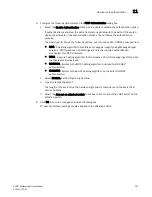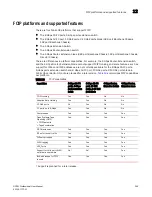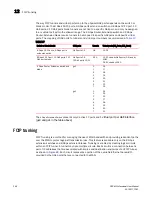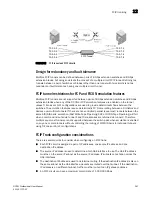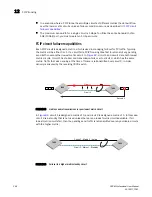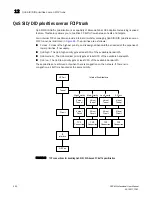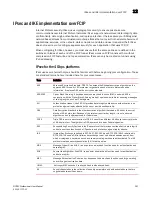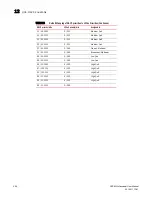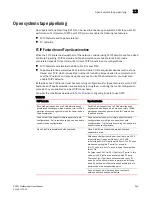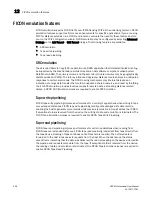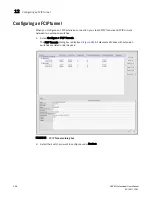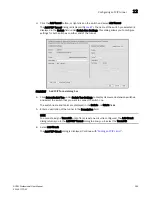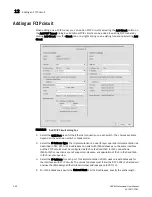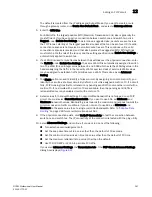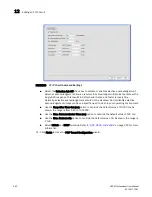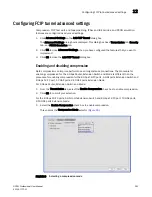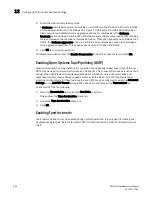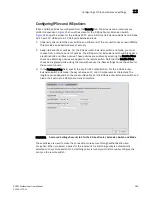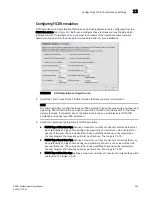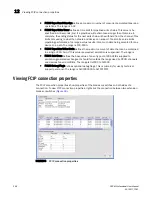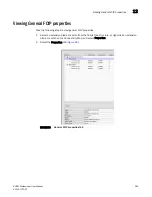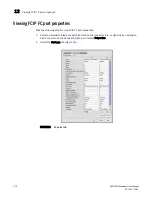
DCFM Professional User Manual
255
53-1001773-01
Open systems tape pipelining
12
Open systems tape pipelining
Open Systems Tape Pipelining (OSTP) can be used to enhance open systems SCSI tape write I/O
performance. To implement OSTP over FCIP, you must enable the following two features:
•
FCIP Fastwrite and Tape Acceleration.
•
FC Fastwrite.
FCIP Fastwrite and Tape Acceleration
When the FCIP link is the slowest part of the network, consider using FCIP Fastwrite and Tape Read
and Write Pipelining. FCIP Fastwrite and Tape Acceleration are two features that provide
accelerated speeds for read and write I/O over FCIP tunnels in some configurations:
•
FCIP Fastwrite accelerates the SCSI write I/Os over FCIP.
•
Tape Acceleration accelerates SCSI read and write I/Os to sequential devices (such as tape
drives) over FCIP, which reduces the number of round-trip times needed to complete the I/O
over the IP network and speeds up the process. To use Tape Acceleration, you must also
enable FCIP Fastwrite.
Both sides of an FCIP tunnel must have matching configurations for these features to work. FCIP
Fastwrite and Tape Acceleration are enabled by turning them on during the tunnel configuration
process. They are enabled on a per-FCIP tunnel basis.
Consider the constraints described in
Table 19
when configuring tunnels to use OSTP.
TABLE 19
FCIP Fastwrite
Tape Acceleration
Each GbE port supports up to 2048 simultaneous
accelerated exchanges, which means
a total of 2048
simultaneous exchanges combined
for Fastwrite and
Tape Acceleration.
Each GbE port supports up to 2048 simultaneous
accelerated exchanges, which means
a total of 2048
simultaneous exchanges combined
for Fastwrite and
Tape Acceleration.
Does not natively support multiple equal-cost path
configurations. Traffic isolation zoning can be used to
support these configurations.
Does not natively support multiple equal-cost path
configurations or multiple non-equal-cost path
configurations. . Traffic isolation zoning can be used to
support these configurations.
Class 3 traffic is accelerated with Fastwrite.
Class 3 traffic is accelerated between host and
sequential device.
With sequential devices (tape drives), there are 1024
initiator-tape (IT) pairs per GbE port, but 2048
initiator-tape-LUN (ITL) pairs per GbE port. The ITL pairs
are shared among the IT pairs. For example:
Two ITL pairs for each IT pair as long as the target has
two LUNs.
If a target has 32 LUNs, 32 ITL pairs for IT pairs. In this
case, only 64 IT pairs are associated with ITL pairs.
The rest of the IT pairs are not associated to any ITL
pairs, so no Tape Acceleration is performed for those
pairs. By default, only Fastwrite-based acceleration is
performed on the unassociated pairs.
Does not support multiple non-equal-cost path
between host and sequential device
Summary of Contents for Brocade BladeSystem 4/12
Page 1: ...53 1001773 01 14 April 2010 DCFM Professional User Manual Supporting DCFM 10 4 X ...
Page 3: ...DCFM Professional User Manual iii 53 1001773 01 ...
Page 4: ...iv DCFM Professional User Manual 53 1001773 01 ...
Page 88: ...56 DCFM Professional User Manual 53 1001773 01 Seed switch 2 ...
Page 146: ...114 DCFM Professional User Manual 53 1001773 01 Customizing the main window 4 ...
Page 152: ...120 DCFM Professional User Manual 53 1001773 01 Launching HCM Agent 5 ...
Page 246: ...214 DCFM Professional User Manual 53 1001773 01 Syslog forwarding 8 ...
Page 262: ...230 DCFM Professional User Manual 53 1001773 01 Generating zoning reports 10 ...
Page 662: ...630 DCFM Professional User Manual 53 1001773 01 ...

